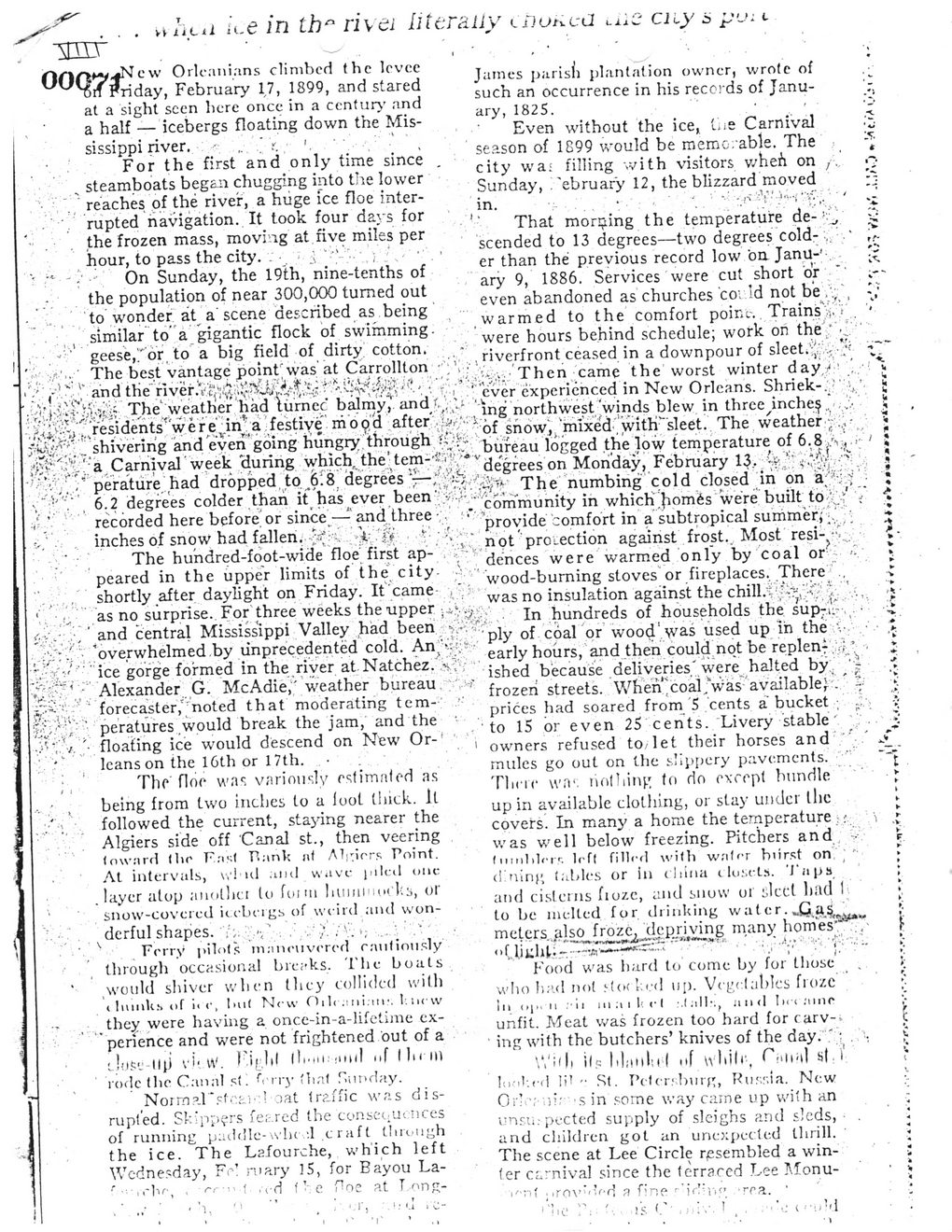This text was obtained via automated optical character recognition.
It has not been edited and may therefore contain several errors.
xnf
w /itw n-€ )n th* rivei literally <-Dotvcu >.±ic cay a ptn
da
:w Orleanians climbcd (he Icvcc iday, February 17, 1899, and stared at a sight seen here once in a century and a half — icebergs floating down the Mississippi river.
For the first and only time since _ steamboats began chugging into the lower / reaches of the river, a huge ice floe interrupted navigation. It took four days for the frozen mass, moving at five miles per hour, to pass the city. . • J " v •- On Sunday, the 19th, nine-tenths of the population of near 300,000 turned out to wonder at a'scene described as being similar to’ a gigantic flock of swimming, geese,!"'or to a big field of dirty, cotton.
James parisfi plantation owner, wrote of such an occurrence in his records of January, 1825.
Even without the ice* lue Carnival season of 1899 would be memorable. The city wa.r filling with visitors whefi on /. Sunday, i'ebruary 12, the blizzard moved in. • . . ' ''fiy ' ‘
That morning the temperature de- '<'j' scended to 13 degrees—two degrees cold- V er than the previous record low 'on Janil-’ . ary 9, 1886. Services were cut short or even abandoned as churches cor.ld not be .V, warmed to the comfort point., Trains ‘ were hours behind schedule; work on the'* c ' , riverfront ceased in a downpour of sleeti^> i'
15.
>
ff'
The best vantage point'was at Carrollton ; * • * .. a ~
^ Then -came the worst winter day.
v <;'i.':'cvere - -- -
and the" river
. r ever experienced in Nc
J ing northwest'winds b -we,r.e-.ln.«a ?estI?S af!er “if sA^Wj“witK’
'.’hX:>r'f- chivftrinp and even comer hunerv thrniieh fcfhi , ,• •
'^ ever experienced in New Orleans. Shriek-;"
blew in three inche$ ""sleet. The weather
low temperature of 6.8 .v. February
' , * j *'' ,r '■ •i’ t, '' t •,v.,.'-yi* 111 v cold closed in on a^vi^ ■
6.2 degrees colder than it has ever been:^^^,,-,, /•“
• ■- •• , ,, ... . community m which homes were built to? *
recorded here bd.re.or since - and three •'•.>ptov!<te-comfort in a subtropical
lnn>«of5m.wl,:u! fa!U-n. v;. » ■ . . • )!ot pr, action against frost.. Most resi-X ■
The hundred-foot-w.de floe first ap- .--'*denCi,s were warmed by coai or> -
peared in the upper limits of the city shortly after daylight on Friday. It came
. ■ tj, as no surprise. For three weeks the upper
n m /-> r\ n f »*n I nn 1 rri r (•! rvr\1 1/ ollfiir V» r» /-f K Aafl . ‘
. . wood-burning stoves or fireplaces. There7 was no insulation against the chill.v|i?5&- . In hundreds of households the siip-i:--.
■ K ■
<
. ... 6'J1 &c iui iiicu ill u*c(iivci. ai.inau.uc4. .■s.,;5 . JsJjecJ £
Alexander G. McAdie,'- weather bureau. frozerj
" forecaster,' noted that moderating tern- v j
■' peratures would break the jam, and the prices
5 floating ice would descend on New Or-'
i leans on the 16th or 17th.
' ; _ ' The floe was variously estimnfed as ■ K being from two inches to a loot thick. It followed the current, staying nearer the Algiers side off Canal st., then veering toward the Fast P>ank at AT|Mrrs Point.
At intervals, wl ul and wave pilt-il one .layer atop anolhti to foim of
snow-Co\'cicd "ucbi'igh of wt-ird and wonderful shapes. 7v. v:T. ; • •• /■ ■ V
Ferry pilots manmvcrcd r.autiously through occasional breaks. The bouts ^vould shiver when they collided will)
< ImnUs of ii <•, I>u( N c w O i lea ni.-mr. I'.ncvv they were having a once-in-a-lifetime experience and were not frightened out of a lJmS'J-IIJ) vi‘ VV. llt-Mi: -lull nf I 111 in
rode (he Canal st! Amt}' tliat r>iinday.
Norrn?.r‘?t>'.t.i :l oat traffic was disrupted. Skippers feir.red the conseout nces of running paddle-whc '.1 c raf t through the ice. The Lafourche, which left Wednesday, Fr\ mary ]5, for Bayou La-
streets. \\Then'coal,‘was avai 1 ab 1 eJ -. -had soared from S cents a' bucket ; to 15 or even 25 cents. Livery stable' owners refused to let their horses and ”‘ mules go out on the slippery pavements. Time wl)'; tiolhin^ to do except bundle up in available clothing, or stay under I lie covers. In many a home the temperature ;; was well below freezing. Pitchers and,
1111111 ilcrr Irft filled with water burst on ' '■ dining tables or in c hina i lust-ls. Taps and cisterns fiozc, and snuw oi Jcct had 1; to be melted for drinking watcr.^Qa^^ meters also froze, depriving many homes’ . T
--- '> ' ;■ ■ -
Food was hard to come by for those who had not Moc I:</d up. Vegetables froze ' 111 a i !•' el •.( a 11-., a n <1 Ini .'inir
-,,-h
•d f
n
oe
i,
at T ong-
. U i C-
tu <>p* 11 : it mi a i i. i i ... ,in
unfit. Meat was frozen too hard for carv-i ing with the butchers’ knives of the day.7--'';
Willi ilp lilaiilu ( of wliilr, Canid s|. I lool-.rd Ii^ -• St. TYfer.'.burg, Ku.'.r.ta. New Oiii’.'-ni; s in some way came up with an unsti: pected supply of sleighs and sleds, and children got an unexpected thrill. The scene at Lee Circle resembled a winter carnival since the terraced Lee Monu-v:->{ ..rov’ded a fine r'id-'n.o; -rea. '
1 'lie IV 'is , j;:v. l ■■ 'tdd

New Orleans and Louisiana Document (067)